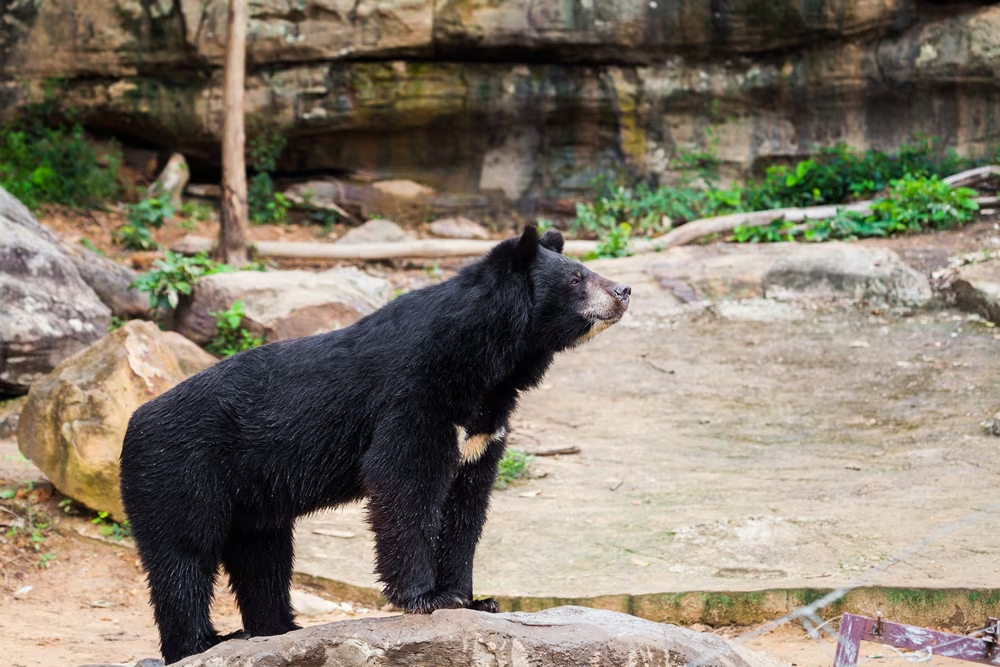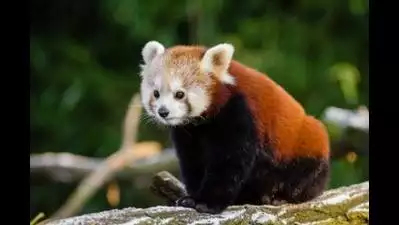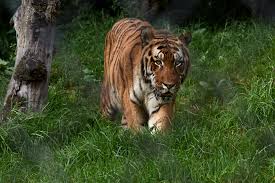1. BLACK BEAR

The Black Bear: An Emblem of the Wild
A characteristic of this animal, with distinctive black fur at times varying from brown to cinnamon coloration, inhabits a wide range of environments across the continent. The black bear (Ursus americanus) is one of the most iconic wildlife species in North America. Unknown to what its name would entail, the black bear is not necessarily black and may vary in color from deep black to dark brown and, in rare cases, even blond or blue-gray, especially the “spirit” bears found in British Columbia. These intelligent species can thrive in a variety of habitats, from dense forests to mountainous regions and as close as to human settlements.
Physical Characteristics
The average length of a black bear is about 5 to 6 feet long, and their weight is between 150 to 600 pounds. The male is bigger compared to the female. Black bears have a short coat with a shaggy appearance and also a robust body, supported by well-developed legs along with sharp claws; their claws facilitate them in climbing smooth trees easily. Their head is relatively small, measured relative to the body, with rounded ears and a long, straight snout. The sense of smell is developed highly, which helps in searching for food on the ground.
Diet and Behaviour
Black bears are omnivorous and really eclectic eaters. They eat vast amounts of vegetation, but berries, nuts, and roots make up most of the diet, while they wolf down fish, insects, and small mammals when those are available. Perhaps the most interesting thing about black bears is their opportunistic feeding behavior and susceptibility to raiding human food sources, especially in areas with frequent human-bear encounters. That flexibility has allowed black bears to thrive in increasingly fragmented habitats.
Black bears enter the state of hyperphagia in the fall, where they ingest extremely large amounts of food as a way of building up fat reserves. Such feeding helps to protect them during hibernation, as they sleep deeply in order to minimize energy utilization. In this state, the heart rate and metabolism of a black bear decrease in such a manner that they can survive without eating and drinking for months. These bears do not hibernate at all or only hibernate for a period in warmer regions.
Habitat and Range
Black bears occur over a wide range of land: from Alaska to Mexico, throughout most of Canada and the United States. They prefer largely forested areas, especially with dense understory in which they can feed and hide. However, black bears can adapt themselves to various habitats, whether in the swamps, tundras, or even the deserts. Recent decades have seen increased sightings of black bears within human settlement areas due to the increasing encroachment of urbanization on their natural habitats.
Behavior and Social Structure
Unlike grizzly bears, which are generally aggressive, black bears are usually shy and solitary by nature and primarily avoid confrontations. They are not usually aggressive towards man or other animals, but they will defend themselves if cornered, especially when a female is protecting cubs. Black bears in the wild will often retire to trees or thick cover if confronted. However, they can become much more aggressive if they have learned that humans have available food, and this can be a very dangerous situation.
Conservation and Human Interaction
A central part of North America’s ecosystems for thousands of years, black bears have been hunted throughout history for their meat, fur, and body parts but are no longer a concern with modern conservation efforts maintaining populations in most areas. Continuing threats include habitat destruction and fragmentation. Increased human-bear conflicts are also being documented as a result of increased encroachment of bears into human-dominated landscapes as they move seeking food resources due to urbanization. This would decline with the assistance of “bear-smart” practices, encouraged by wildlife agencies, which also remind individuals who live near bear ranges to secure trash, not leave pet food outdoors, and to store food properly when camping.
Black bears play many significant roles in their ecosystems-their dietary habits help distribute seeds, and they are part of a large process that controls the populations of insects. Their flexibility already appears robust enough to ensure survival in shifting landscapes, in addition to whatever else may be facing them.
In conclusion, the black bear is still an icon of wilderness and beauty in the natural realm, drawn upon for respect toward strength, intelligence, and resilience. Humans should adopt living conditions that can live with bears despite increased human developments.
2. RED PANDA

image taken by freepikhttp://freepik.com
The Red Panda: A Rare and Lovable Forest Inhabitant
The red panda, Ailurus fulgens, also known as the “lesser panda” or “firefox,” is a unique and beautiful mammal native to the temperate forests of the Himalayas and parts of China, Bhutan, India, Nepal, and Myanmar. Even though it bears part of the name of the giant panda, it is actually a representative of an altogether different family, Ailuridae, and is much closer to raccoons, skunks, and weasels than true bears. Small in size but big in appeal, this elusive creature has won hearts because of its beautiful looks and amiable ways.
Physical Characteristics
Red pandas are relatively small, weighing between 8 to 14 pounds and measuring about 20 to 26 inches in body length with an additional 12 to 20 inches in their bushy tails. Their thick fur is reddish-brown with a lighter underside, while their faces sport white markings similar to those of a raccoon. The red panda has almost a teddy bear’s face, with its large, round head, short snout, and pointed ears. It is so cute. Its bushy, ringed tail helps this animal balance its way through the trees and keeps it warm in the cold.
A red panda has short covered fur and is small-sized. It has semi-retractile claws that it uses for climbing trees and holding onto the bamboo stems, which happen to constitute most of its diet. The red pandas are agile climbers despite their tiny size, and they often spend their time in trees asleep, foraging, or escaping predators.
Diet and Feeding Habits
Like the giant panda cousins, red pandas have a diet composed primarily of bamboo. However, as technically omnivores, these red pandas also eat occasional portions of berries, acorns, roots, and small insects besides shoots and leaves of bamboo. They utilize their very specialized wrist bone working like a “false thumb” to grasp the bamboo while they are eating. Though it isn’t nutritious, red pandas maintain such high amounts of bamboo consumption to keep energy levels up. They browse up to 13 hours daily to gather food.
During the winter months when the bamboo and other materials are not readily available, red pandas have been known to hunt small mammals and birds to complement their diet. Most of the time, red pandas are exceptional from other carnivores as they consume a diet of very high fiber and low energy source. This explains how they move around, slowly and deliberately.
Habitat and Range
Red pandas dwell in temperate forests, especially those with thick bamboo undergrowth. They excel in cold, mountainous situations between 1,800 and 4,000 meters above sea level, which corresponds to 6,000 to 13,000 feet. Since they have those trees to climb up and plenty of bamboo to graze on, the red pandas are quite well off regarding food supply. Unfortunately, their habitat has considerably been reduced due to habitat loss caused by deforestation and human settlement, forcing them to live in a scattered population and reducing its number.
Behavior and Social Structure
Red pandas are animals that only come together during the breeding season. Animals are also most active during dawn and dusk crepuscular, though they spend a greater deal of time resting within the comfort of trees because resting is less caloric. They often wrap long tails around their bodies to keep them warm while in cold weather.
Red pandas are also playful by nature, especially for the young ones-they tend to be wrestling, chasing, and investigating their surroundings. They communicate through vocalizations such as squeals, huffs, and whistles but also use scent marking by means of scent glands on their feet.
Males and females have separate territories, marked with scent glands and urine. The female gives birth to one to four cubs after a gestation period of about 135 days, usually during the latter part of spring or the beginning of summer. The cubs are born blind and helpless and remain so for several months before being able to fend for themselves.
Conservation Status
Red pandas are listed as endangered species in the IUCN Red List with just fewer than 10,000 individuals remaining in the wild. Their population is degrading steadily because of habitat destruction, poaching, and inbreeding among fragmented populations. Another challenge to red pandas is illegal pet trade plus accidental trapping for other species.
Red panda conservation involves efforts in habitat preservation, anti-poaching campaigns, and captive breeding programs. Several countries have created red panda reserves and protected areas, while the like of the Red Panda Network works in raising their social voices as well as conducting conservation awareness in communities.
#
The red panda is an attractive and endangered species, playing a vital role in the ecosystems of the Himalayas and the surrounding regions. Being cute, possessing special adaptations, and counted among the world’s endangered species, this red panda managed to capture the hearts of many people on earth. To preserve the wonderful creature, conservation efforts have to be a continuous cycle combined with habitat protection in order to preserve the red panda and their very fragile forest home.
3. tiger

The Nainital Zoo, locally known as the Pt. G.B. Pant High Altitude Zoo, is one of India’s most thrilling wildlife reserves, situated 2,100 meters high above in the Kumaon region of Uttarakhand. Located in the picturesque hill station of Nainital, this zoo is home to diverse variety of wildlife, which has long, gentle, and beautiful creatures-the majestic tiger-which speaks volumes about power and grace in Indian culture. For many visitors, it is the big jaguar embodying the wild spirit of Indian jungles.
Nainital Zoo is special in that its height from sea level creates a natural living condition for many species of animals which are actually favored by cooler climates. It spreads over 4.6 hectares amidst lush green surroundings, providing the perfect environment for both animals and visitors alike. Dedicated to saving endangered species and providing a safe haven for animals, it has been turned into an abode for fans of wildlife as well as tourists.
Among the many species kept in the Nainital Zoo, surely one that stands out as the most awe-inspiring is the Bengal tiger. The Bengal tiger, or Panthera tigris tigris, is one of the most famous subspecies of tigers, and its natural range stretches right across the Indian subcontinent. It has totally devoted itself to the preservation of this magnificent animal species now endangered due to loss of habitat, rampant killing due to poaching, and human-wildlife conflict. Apart from the above point, the zoo also plays a part in the process of conservation by providing a safe habitat that will help guarantee survival for future generations.
The Nainital Zoo has approached the construction of enclosures for tigers in a particular way, characterized by dense foliage open spaces and water features or general environments simulating conditions in the tiger’s natural habitat. Such an environment encourages natural stalking or playing or cooling off in water-phenomena that fascinated visitors at the zoo. Seeing a tiger in such an environment, even in captivity, makes one’s perceptions of how much power and grace the animal embodies. For most visitors, seeing a tiger up close can be the most humbling experience since the animal’s quiet power and intense gaze both inspire awe and respect.
But at Nainital Zoo, it makes poignant a visitor aware of the challenges they face in the wild. It houses more than half of the world’s tigers. Still, poaching activities and dwindling habitats pose lots of threats to the country. In such efforts, a zoo like Nainital very much helps educate the people about the need to save tigers and urgent need to preserve them in their natural habitat.
Nainital Zoo emphasizes a lot on environmental education and awareness. With this intention, the zoo encourages the people visiting to know more about the inhabitants of the zoo including the tiger and thus getting an understanding of the much-needed biodiversity preservation measures. The zoo continues to provide guided tours of information boards with educational programmes specifically designed for children.
The Nainital Zoo becomes a sort of sanctuary for endangered species-including the Bengal tiger-and a place where humans can visit to connect with nature. It inspires visitor appreciation toward wildlife conservation and the beauty of the creatures that share this planet with us. The Tiger strides majestically in a virtually shaded enclosure, a background to the magnificent Himalayas, bequeathing memories of wild places and creatures still yearning for protection.